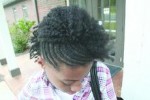
“You’re just a flat-chested, bald-headed bimbo,” said one of my routine tormentors during a seventh grade history lecture. Adrenaline surged. My heart palpitated. Fingertips trailed the coils on my neck. I wrapped a special finger around the curls and left it there for a moment. I tapped the beady beads for clarity. She got the message, and was momentarily silenced.
I was subjected to habitual harassment during adolescence because of my evolving appearance.
My parents assured me that I’d avoid weight sagas that the young “fine” girls would experience as metabolisms slowed and gravity sought revenge, so I wasn’t fazed by her breast comment.
I routinely made the honor roll and received consistent praise from instructors and family members for academic accomplishments.
So the bimbo comment didn’t bother me. But the bald-headed part? That crossed the line.
I began the transition from relaxed hair to a natural during sixth grade. Ten months later, at age 12, my mom cut the remaining processed hair and sent me to school with a rolling backpack, clunky violin case and an Afro quenched from Sta Sof Fro precipitation.
Hormonal pubescent hellions reminded me that the rebellious mass of heritage on my scalp was less than appealing to them.
Before my mom chopped the relaxed ends off, I came to school one day with about three and a half inches of new growth and the remaining straight hair pulled into a tight ponytail.
I was more concerned with elongated limbs and seemingly diminishing coordination than I was with my hair – until my peers reminded me that I was a deviation.
“Look at her nappy hair,” exclaimed a petite girl with Napoleonic issues and fading edges.
The class looked at my naps. They stared. They laughed. It was as if the Garden of Follicle Eden had been upset. I was naked.
They discovered my secret. My natural hair texture is not straight. I was no good because my hair seemingly wasn’t.
Hair sagas continued throughout the next five years until I decided to lock my hair. I had my hair colored, curled, juiced, dried, fried, braided, plaited, twisted, flattened, fluffed, knotted, trimmed and extended.
After months of satisfying a bleach, baby oil and flat iron addiction, I revisited my hairstylist. She clipped massive amounts of split yellow hair. It looked like a pile of hay around the chair.
Summertime was upon us and the family prepared for a vacation. So my mom paid for two-strand twist lock extensions to be put in my hair. I wore them for a little more than two months.
It was in Costa Rica that I decided I wanted authentic locks. My dad and I walked through a market area. The intent was to purchase jewelry at a discounted price.
“Bonita,” said one of the Ticos. “I like your hair.”
Several other young men smilingly echoed. My dad didn’t even mind.
It was a profound moment because being raised in the internalized racism-embedded South, I was socialized to find people with multiracial lineage and the indicative curl patterns, more attractive than brothas and sistas without the genetic wet and wavy.
Yet amid scores of loose beach curls, my matted tresses and deep skin color commanded attention. Accepted notions of beauty are always a matter of perspective.
As for the tormentor, she requested me on Facebook not too long ago. I accepted, but I also noticed that her relaxed bob is now about the same length and texture as mine was when she made disparaging remarks.
But I won’t call her a bimbo or flip her the finger.
